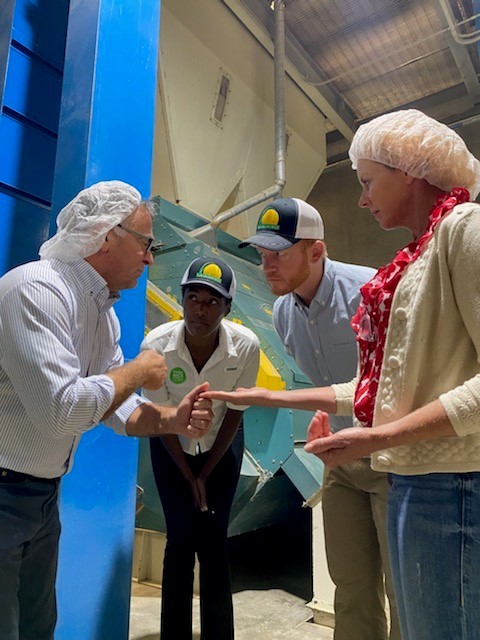 Steve Vargas and Karye Benton of Sun Valley Rice Mill, huddle with Asiha Grigsby and Curtis McCoy to share production information
Steve Vargas and Karye Benton of Sun Valley Rice Mill, huddle with Asiha Grigsby and Curtis McCoy to share production information
Sep 20, 2022
SACRAMENTO, CA – Last week, USA Rice hosted Foreign Agricultural Service (FAS) Agriculture Attaché Curtis McCoy on a tour of California rice country. McCoy’s FAS portfolio includes rice as well as wheat and corn. His first experience with the U.S. rice industry came when he visited Louisiana in June of this year.
McCoy was accompanied on the trip through the Sacramento Valley by Asiha Grigsby, USA Rice director of international promotion for the western hemisphere. The two share a common bond as Returned Peace Corps Volunteers who focused on agricultural initiatives in their host countries of Senegal and El Salvador, respectively.
Grigsby and McCoy traversed more than 100 miles to engage with USA Rice members at every stage of the farm to fork process, learning about the triumphs of California rice through sustainability projects and the challenges of water allocation and decreased acreage that the region is currently facing.
Greg Van Dyke, whose family farms in Pleasant Grove, explained why some of his fields now lay fallow due to the California drought and water restrictions that have ultimately led to a reduction of nearly half California’s planted acres. Leo LaGrande, based in Williams, farms rice as well as tomatoes, cucumber, walnuts, almonds, and cattle, and stressed the importance of his rice crop as added value to the land for animals that creates habitats on flooded fields.
At Montna Farms in Yuba City, owner Nicole Van Vleck showed conservation in action as one of her flooded rice fields served as a resting place for nearly 230 species of migrating waterfowl and shorebirds on the Pacific Flyway. Paul Buttner, manager of environmental affairs for California Rice Commission, talked about how conservation efforts have been extended from waterfowl to fish through the salmon environmental initiative to help recover struggling salmon populations with floodplain farm field management.
Grigsby and McCoy toured Van Dyke Dryers, which has been in that family for more than 100 years, and incorporates solar power to reduce energy consumption. Sun Valley Rice Mill in Arbuckle is also powered by solar energy. There, Steve Vargas and Jennifer Kalfsbeek explained how their rice, sourced from local farmers, is milled and packed with eco-friendly materials for Asian markets with high quality standards. Chris Crutchfield of American Commodity Company debuted their newest technology for transforming rice hulls into nutrient rich biochar that is sold for use in various co-products such as potting soil and cosmetics, emphasizing how they strive for no waste from any part of the rice grain.
“While the effects of chronic drought here have led to a nearly 50 percent reduction in planted acres from 500,000 in 2021 to about 250,000 in 2022, it’s heartening to see the California rice industry remains resilient in their conservation efforts and continues to maximize all the resources at their disposal” said Grigsby.
California is the third largest rice-producing state behind Arkansas and Louisiana, specializing in short and medium grain Japonica varieties. On average, the California rice crop generates $900 million in value each year.